


 الفيزياء الكلاسيكية
الفيزياء الكلاسيكية
 الكهربائية والمغناطيسية
الكهربائية والمغناطيسية
 علم البصريات
علم البصريات
 الفيزياء الحديثة
الفيزياء الحديثة
 النظرية النسبية
النظرية النسبية
 الفيزياء النووية
الفيزياء النووية
 فيزياء الحالة الصلبة
فيزياء الحالة الصلبة
 الليزر
الليزر
 علم الفلك
علم الفلك
 المجموعة الشمسية
المجموعة الشمسية
 الطاقة البديلة
الطاقة البديلة
 الفيزياء والعلوم الأخرى
الفيزياء والعلوم الأخرى
 مواضيع عامة في الفيزياء
مواضيع عامة في الفيزياء|
Read More
Date: 7-10-2020
Date: 5-10-2020
Date: 19-12-2020
|
Complex analysis
Let us now investigate another ''trick" for solving Poisson's equation (actually it only solves Laplace's equation). Unfortunately, this method can only be applied in two dimensions. The complex variable is conventionally written
 (1.1)
(1.1)
(z should not be confused with a z-coordinate; this is a strictly two dimensional problem). We can write functions F(z) of the complex variable just like we would write functions of a real variable. For instance,
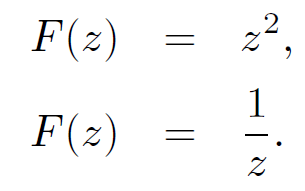 (1.2)
(1.2)
For a given function F(z) we can substitute z = x + i y and write
 (1.3)
(1.3)
where U and V are two real two dimensional functions. Thus, if
 (1.4)
(1.4)
then
 (1.5)
(1.5)
giving
 (1.6)
(1.6)
We can define the derivative of a complex function in just the same manner as we would define the derivative of a real function. Thus,
 (1.7)
(1.7)
However, we now have a slight problem. If F(z) is a ''well defined" function (we shall leave it to the mathematicians to specify exactly what being well defined entails: suffice to say that most functions we can think of are well defined) then it should not matter from which direction in the complex plane we approach z when taking the limit in Eq. (1.7). There are, of course, many different directions we could approach z from, but if we look at a regular complex function, F(z) = z2, say, then
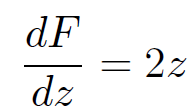 (1.8)
(1.8)
is perfectly well defined and is, therefore, completely independent of the details of how the limit is taken in Eq. (1.7). The fact that Eq. (1.7) has to give the same result, no matter which path we approach z from, means that there are some restrictions on the functions U and V in Eq. (2.3). Suppose that we approach z along the real axis, so that δz = δx. Then,
 (1.9)
(1.9)
Suppose that we now approach z along the imaginary axis, so that δz = i δy. Then,
 (1.10)
(1.10)
If F(z) is a well-defined function then its derivative must also be well defined, which implies that the above two expressions are equivalent. This requires that
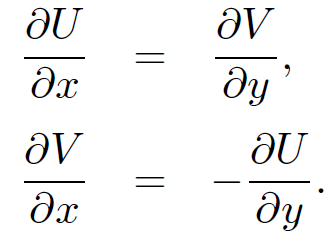 (1.11)
(1.11)
These are called the Cauchy-Riemann equations and are, in fact, sufficient to ensure that all possible ways of taking the limit (1.7) give the same answer. So far, we have found that a general complex function F(z) can be written
 (1.12)
(1.12)
where z = x + i y. If F(z) is well defined then U and V automatically satisfy the Cauchy-Riemann equations:
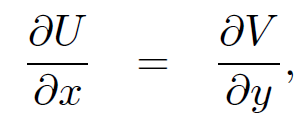
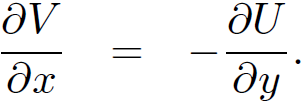 (1.13)
(1.13)
But, what has all of this got to do with electrostatics? Well, we can combine the two Cauchy-Riemann relations. We get
 (1.14)
(1.14)
and
 (1.15)
(1.15)
which reduce to
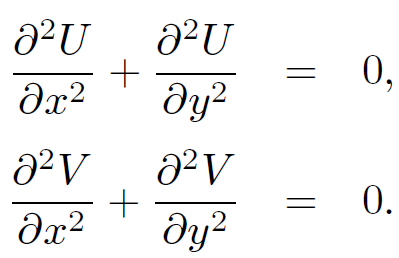 (1.16)
(1.16)
Thus, both U and V automatically satisfy Laplace's equation in two dimensions; i.e., both U and V are possible two dimensional scalar potentials in free space. Consider the two dimensional gradients of U and V :
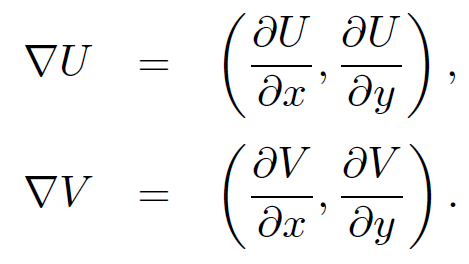 (1.17)
(1.17)
Now
 (1.18)
(1.18)
It follows from the Cauchy-Riemann equations that
 (1.19)
(1.19)
Thus, the contours of U are everywhere perpendicular to the contours of V . It follows that if U maps out the contours of some free space scalar potential then V indicates the directions of the associated electric field lines, and vice versa. For every well-defined complex function F(z) we can think of, we get two sets of free space potentials and the associated electric field lines. For example, consider the function F(z) = z2, for which
 (1.20)
(1.20)
These are, in fact, the equations of two sets of orthogonal hyperboloids. So,
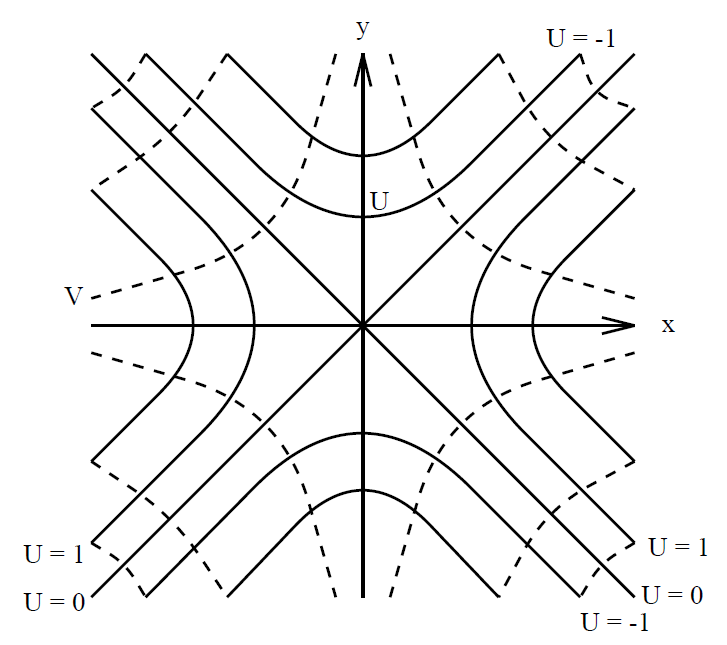
U(x, y) (the solid lines in the figure) might represent the contours of some scalar potential and V (x, y) (the dashed lines in the figure) the associated electric field lines, or vice versa. But, how could we actually generate a hyperboloidal potential? This is easy. Consider the contours of U at level ±1. These could represent the surfaces of four hyperboloid conductors maintained at potentials ± . The scalar potential in the region between these conductors is given by
. The scalar potential in the region between these conductors is given by  U(x, y) and the associated electric field lines follow the contours of V (x, y). Note that
U(x, y) and the associated electric field lines follow the contours of V (x, y). Note that
 (1.21)
(1.21)
Thus, the x-component of the electric field is directly proportional to the distance from the x-axis. Likewise, for the y-component of the field. This property can be exploited to make devices (called quadrupole electrostatic lenses) which are useful for focusing particle beams. We can think of the set of all possible well defined complex functions as a reference library of solutions to Laplace's equation in two dimensions. We have only considered a single example but there are, of course, very many complex functions which generate interesting potentials. For instance, F(z) = z1/2 generates the potential around a semi-infinite, thin, grounded, conducting plate placed in an external field, whereas F(z) = z3/2 yields the potential outside a grounded rectangular conducting corner under similar circumstances.



|
|
|
|
دخلت غرفة فنسيت ماذا تريد من داخلها.. خبير يفسر الحالة
|
|
|
|
|
|
|
ثورة طبية.. ابتكار أصغر جهاز لتنظيم ضربات القلب في العالم
|
|
|
|
|
|
|
سماحة السيد الصافي يؤكد ضرورة تعريف المجتمعات بأهمية مبادئ أهل البيت (عليهم السلام) في إيجاد حلول للمشاكل الاجتماعية
|
|
|